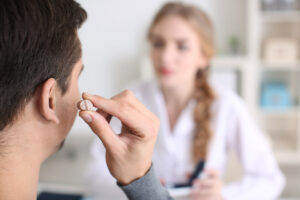The Common Problem of Work-Related Hearing Loss
 According to data collected by the Centers for Disease Control (CDC), some 22 million workers across the United States are at risk every year of hearing loss caused by exposure to excessive occupational noise. The United States Department of Labor estimates that almost $250 million is paid out annually in workers’ compensation claims for hearing injuries or disabilities. Unfortunately, many of those individuals who suffer from work-related hearing loss have irreparable damage before they realize it.
According to data collected by the Centers for Disease Control (CDC), some 22 million workers across the United States are at risk every year of hearing loss caused by exposure to excessive occupational noise. The United States Department of Labor estimates that almost $250 million is paid out annually in workers’ compensation claims for hearing injuries or disabilities. Unfortunately, many of those individuals who suffer from work-related hearing loss have irreparable damage before they realize it.
What Industries Pose the Greatest Risk of Hearing Loss or Injury?
A normal conversation typically involves sounds emanating at about 60 decibels (dB). Here are some of the most hazardous work environments for your ears:
- Flight crews/airline workers—Upon takeoff, a jet can emit sounds up to 130 dB, which can tear an eardrum.
- Ambulance drivers—The typical siren screams out at about 120 dB.
- Mining crews—Most mining operations involve noises up to 115-120 dB.
- Construction workers—Power tools, jackhammers, and heavy equipment can reach levels up to 110 dB.
- Factory and foundry workers—The sounds from trucks and machinery often exceed 115 dB.
- Farmers—Whether tractors (about 100 dB) or squealing pigs (up to 130 dB), the sounds to which farmers are exposed make them highly susceptible to work-related hearing loss.
What Kinds of Hearing Injuries Are Caused by Work-Related Noise?
Workplace hearing injuries generally take two forms:
- A ruptured or perforated eardrum—Some injuries involve a hole or tear in the tissue that separates the ear canal from the middle ear. Loud noises create sound waves, which can have enough force to rupture or tear the eardrum membrane.
- Noise-induced hearing loss (NIHL)—Your inner ear has delicate hair cells, called cilia, which are critical to unimpaired hearing. Sounds that are too close or too loud, or that last too long, can damage the cilia. Unfortunately, the cilia have no ability to heal or regenerate.
How Are Noise-Related Injuries Diagnosed and Treated?
The common symptoms of NIHL include:
- Uncharacteristic feeling of pressure in your ear
- Loss of hearing in the high frequency range—birds or whistles, for example
- Ringing in your ears (tinnitus)
- Hearing speech as muffled or distorted
To confirm a diagnosis of NIHL, you’ll need to have your hearing tested by an audiologist. Audiologists commonly diagnose hearing loss with an audiometer test, where the patient listens for sounds and words through headphones to establish the quietest sounds they’re able to hear.
Contact InjuredCare to Find a Doctor to Treat Your Hearing Loss
To get connected with an experienced doctor who can determine whether you have noise-induced hearing loss, contact us online or call our offices today at 866-952-7045.

